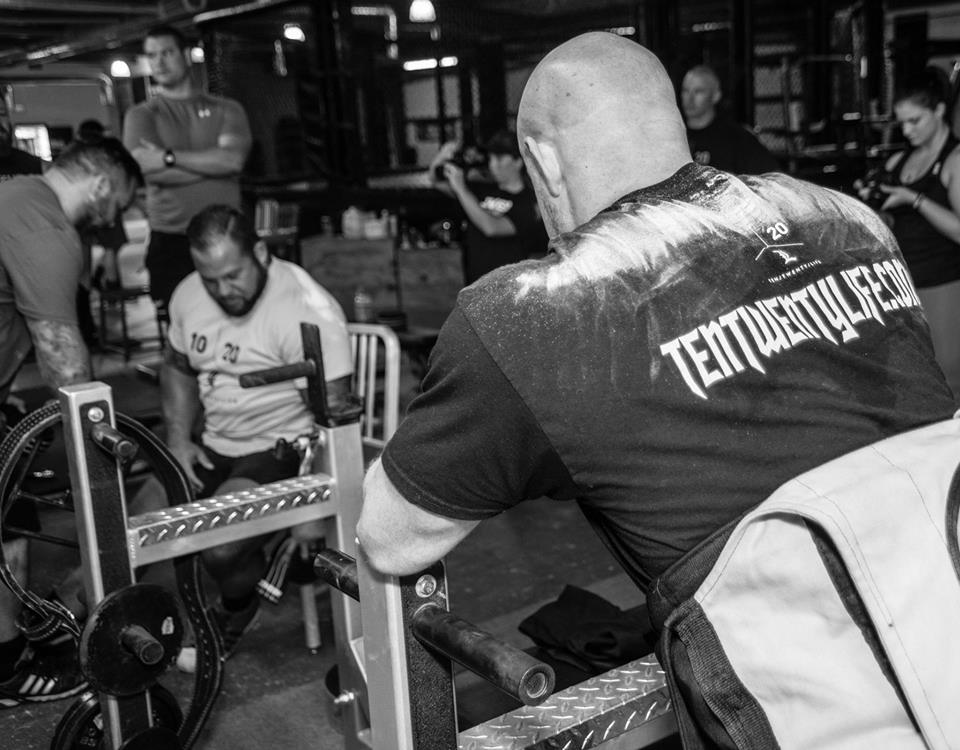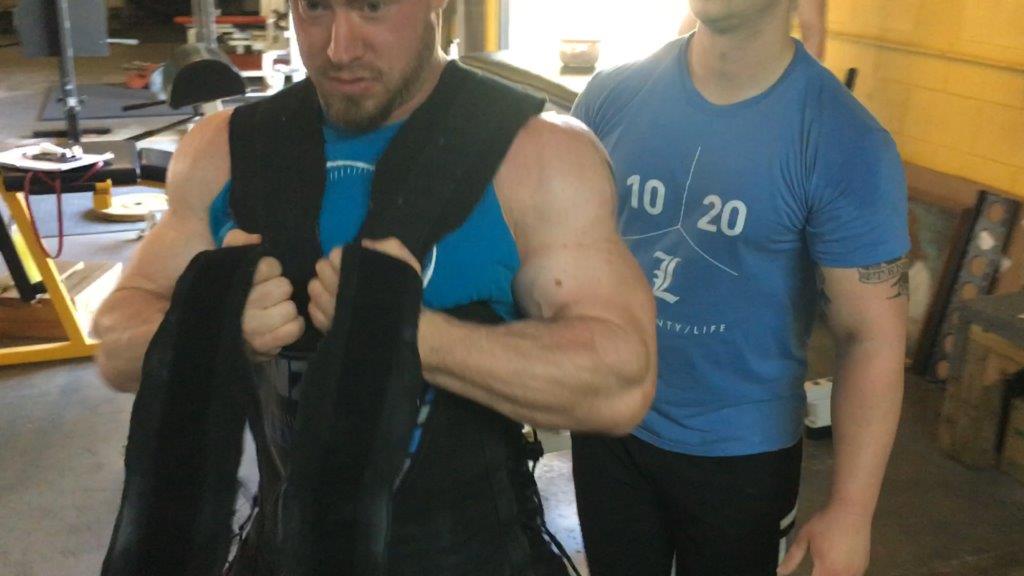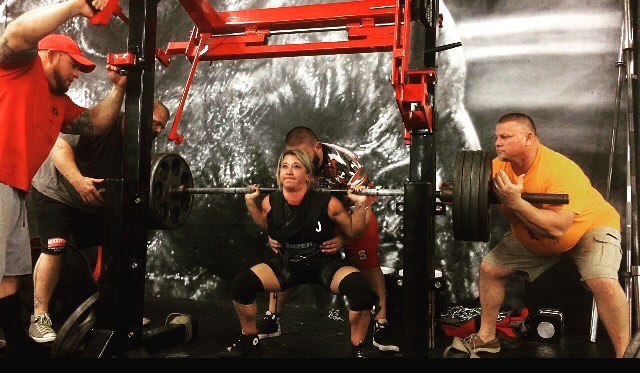
30 Oct Putting Newbies Into Gear
By: Will Kuenzel
At some point the dark side of powerlifting starts to creep into the back of your mind. Gear, equipment, “cheating”. Whatever the Rawng folks are calling it these days. Those of us that don’t care, we call it, “having fun.” If you’ve been in powerlifting long enough you’ve either seen it or been around it. Guys and gals stuffing themselves into some really tight and supportive material all for the sake of a larger total and a little something different.
[wa-wps]
My first foray into powerlifting was straight into gear; big mistake. I came from a bodybuilding routine of higher reps and straight into a powerlifting routine in gear to peak for a meet. Not smart. My joints and tendons were not ready for the increased load. I had muscular endurance for days but there also needs to be higher intensity capacity that just was not there. When folks come into my gym and ask about powerlifting, I get all excited but I do mention my one rule (well, besides “don’t be stupid”) you’ve got to have two raw meets under your belt before you can get into gear. That’s right, the gear whore that I am makes folks do it raw first.
I feel it’s incredibly important to have that powerlifting base. I don’t care what you’ve been doing prior to getting in gear but if you have not competed in at least two raw meets, I just don’t see you doing well by getting into gear. Weaknesses are heavily exposed and the increased loads have a tendency to develop tendinitis very quickly in those unprepared. I’m also not talking about doing two meets on back to back weekends. I mean a nice long off season followed by a productive pre-meet cycle, those similar to the ones that we follow with the 10/20/Life philosophy. This is usually about a year of dedicated training to the sport of powerlifting. And I do mean, compete. You need to sign up and put up a total in a legit federation. Get out of the gym and on the platform. Besides gaining a little more respect for showing up and performing, you’ll never train with quite the same intensity as you do when there’s a meet on the line. Without that focus, training is just working out and that’s just not the same.
Now that the hard part is out of the way we can focus on actually getting into the gear and things I look for when first introducing a raw lifter to gear. For new lifters I start with a loose pair of briefs (or suit with straps down) and a loose bench shirt. I don’t use the sling shot or similar products to replace shirted work. The groove is not there and it’s not going to help build the proper movement pattern. Briefs or a suit with the straps down is a great way to start for squats and deads. Remember this is just an intro, and similar to how a front squat and a back squat are different versions of the squat, same is with raw and geared squats. They’re different versions of the same thing, so there will be a small learning curve associated with it.
There are two things that are difficult to initially get used to in gear. The first being the pressure. When you’re used to squatting 400lbs for reps but need 450-500 to start to get close to a reasonable depth, that’s a significant overload and the associated pressure that comes with bracing for that load can be a bit overwhelming at first. Not to mention that the rate of descent will be considerably slower, so now time spent under that weight will increase as well. Think about doing all your raw work with a 3-5 second descent and with a possible 1-2 count pause in the bottom. For those raw dive bombers, this is a substantial increase in time spent under load. Holding your breath for that much longer and with the increased weight isn’t the easiest thing to get used to right off the bat.
The other thing is the idea of controlling the gear and using it. You dictate what the gear does, you had better not let it dictate what you do. Even a single layer of material is difficult to adjust to at first. Benching is the worst from the standpoint that most folks’ upper back is already a weak point. A bench shirt is going to want to pull you out of position. Look at the backs of folks that bench over 600lbs, shirted or not. Huge backs. These muscles are required to bench efficiently in a shirt. There is such an increased demand for muscle and strength to handle not only the increased loads but the requirements of the gear. Moving through the groove of any piece of equipment takes patience and strength. Slipping out of the groove and going loose is easy. You’ll lose all potential rebound out of the equipment when this happens though. It’s a fight to stay into position. It’s an exercise in and of itself to control the groove of the gear. Unfortunately, the gear’s groove isn’t easy to stay in. To make the lift easier, it’s harder to fight on the way down. This does enable the lift to be completed easier though. That fight on the way down is what makes guys like Brian Carroll make 1000 plus pound squats look so easy. A hard fight on the way down makes for an (somewhat) easy lift on the way up. Well, at least it looks that way.
To start the process of introducing briefs for squats I will start folks off in briefs with about 70% of their best raw squat. We’ll consistently do triples there. The top priority that I’m looking for is the ability to hold the arch and not let the briefs dictate what happens to the hips as the lifter approaches depth. Depth is not the priority! Let me reemphasize that, depth is not the priority! Technique is the top priority. Squatting to depth is necessary in competition, yes, but I will not sacrifice technique for depth. If a lifter can keep proper technique and hit depth with weight that light, then I’ll find them a tighter piece of gear.
Some lifters are fantastic geared lifters. They just get good in it real quick. For others, unfortunately, it takes more time. With that being said, there’s not proper progress for moving beyond that 70%. Some will make leaps and bounds, others will be stuck dialing in technique, and that’s not even taking into account how tight the gear might be. Be patient. Both as a lifter and a coach. When moving into higher weights and the additional pressure that are outside of the comfort zone, there is so much less room for error. Do not rush the process or the weight. Technique, technique, and more technique. As it appears that they’re holding the technique well, we’ll make adjustments to foot width and things like that as necessary.
Adding the straps to a squat is something I’ll generally reserve for pre-contest. Similar to how Brian Carroll talks about it here.
For those brand new to a squat suit, I will start with super loose on straps. I try to set the straps so they’ll only start to tighten down at parallel or just before. Even training in gear for 10-15 weeks prior to going straps up, that’s a whole other level of pressure. Straps also add a level of tension to the suit that makes sitting back into it that much more difficult. Just as I did with folks brand new to briefs, depth is not initially the concern. Technique is the main concern. As they start to approach depth and I see the suit start to dictate what they do, then I’ll call them up from there. Sitting back into a loaded suit takes patience and trust that the gear will hold and you won’t fall back. As depth gets better and technique improves then we can tighten down the straps more and more.
In the case of the bench, I start new geared lifters with roughly 85% of their best competition max to a 3 board for triples, and sometimes with a bit narrower grip. A little narrower grip allows for a bit more natural tuck that is often difficult to do with a wide grip. It’s tough to put faith in the shirt to take it as low as you should when most raw grooves are a bit higher. Similarly with how I’m not interested in squat depth, I’m not interested in getting the bar to touch the chest with the shirt on either. I’m more interested in making sure the lifter can follow the groove and properly fight the shirt. I will generally follow the same method of breaking in a lifter as I would with breaking in a shirt.
Find out more about breaking in a shirt here.
Deadlifting in gear isn’t much different than squatting. Lifters will generally pull from 3-4” blocks with 70% for triples. Setting up properly in the bottom of a deadlift should be pressure enough. Add in a layer or 2 of material to fight against and the set up will be close to impossible from the floor, or at least initially. Keeping a shorter range of motion helps to insure better set up. There still should be a hard wedge and slack pulled out of the bar. Putting the straps up on the deadlift is dependent upon the lifter’s upper back. With a weak upper back, I generally wait to put straps up until that is fixed. If things are rocking, I’ll go straps up as early as I feel a lifter can take it. Deadlifting is different from squatting in that there is no eccentric motion. You get set up at the top of a squat and ride the bar down. With deadlifting you have to create the tightness at the bottom without any help or pressure from the bar pushing into you. The upper back has to be very strong to help create the wedge and to hold position as the bar breaks the floor. Add in a suit with straps up and now you’re fighting against the suit as well. It’s a lot for a new lifter. Another reason why I recommend a good strong base before getting into gear.
Outside of the increased pressure and the technique required to control the gear, equipped lifting isn’t that different from raw lifting. It’s lifting. Squatting, benching, and deadlifting. It does require a little more help though. Initially, you don’t have to have a massively experienced crew to lift equipped, but it does help. I started completely by myself in my garage. Eventually as the gear gets tighter, the weights get heavier, and the margin for error gets smaller, it starts to become more and more important to have some real help. Don’t be afraid to reach out. Travel once or twice a year and seek out those with more experience. Another set of eyes looking at the details can help. Gear is great in that just a couple little tweaks can make huge differences in tightness and effectiveness. Just don’t be afraid to ask.
I don’t say all this to hope to turn anybody away from geared lifting. Just the opposite, I hope that this helps get more lifters into gear. It’s initially a little frustrating and difficult but deep down, it’s just lifting. All geared lifting does is change out the exercises a little bit and add a few more points to consider for weaknesses. I do feel like geared lifting can add a few years to a lifter’s career. Even if you don’t choose to compete equipped, take the time to learn it and train it. Besides a different stimulus to your normal training, there’s aspects of the gear that help protect joints and can be good tests to determine undiagnosed weaknesses. A little overload at the appropriate time can have beneficial effects as well.
These are just some of the ways I’ve introduced several raw lifters to gear over the years. There’s lots of ways to do it. I do stand by the fact that they need to have competed raw first. Getting in equipment takes commitment. Like anything else, we’ll be unable to become proficient at anything we don’t practice. Commit to the process and learn a little more about yourself and the sport that we dearly love.
Low Country Strength
Latest posts by Low Country Strength (see all)
- LCS Off Season Week 7, Session 1-3 - February 20, 2019
- LCS Off Season Week 6, Session 1-3 - February 20, 2019
- LCS Off Season Week 5, Session 1-2 - February 20, 2019









Sorry, the comment form is closed at this time.